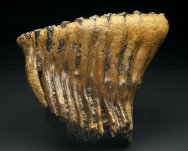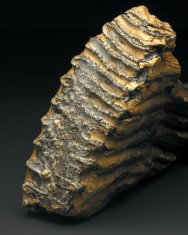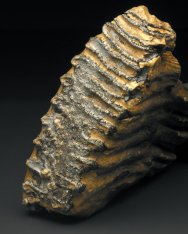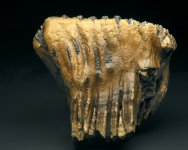Palaeoloxodon
(Elephas) antiquus
Order Proboscidea,
Family Elephantidae, Genus Elephas, (Palaeoloxodon, an extinct subgenus
of elephants)
Order Proboscidea,
Family Elephantidae
Geological
Time: Pleistocene
Size: Fossil
is 18.8 cm is (7 1/2”) in length by 15.6 cm (6 ¼”)
high, by 7.5 cm (3”) in width
Fossil Site:
River Rhine, Worms, Germany
Fossil Code:
PFV187
Price: $700.00
 Description:
This beautiful and striking Palaeoloxodon antiquus molar comes directly
from the Rhineland region of west central Germany. The preservation
is remarkable and natural mineral replacement processes in fossilization
resulted in a color spectrum of light tan/brown hues. At 5 lbs 2
oz (2.309 kg), it’s as heavy, solid and dense as the rock
it became since tens of thousands of years ago when humans were
still roving bands of hunter-gatherers. There are even small pebbles
lodged between the nerve roots of the specimen. This Description:
This beautiful and striking Palaeoloxodon antiquus molar comes directly
from the Rhineland region of west central Germany. The preservation
is remarkable and natural mineral replacement processes in fossilization
resulted in a color spectrum of light tan/brown hues. At 5 lbs 2
oz (2.309 kg), it’s as heavy, solid and dense as the rock
it became since tens of thousands of years ago when humans were
still roving bands of hunter-gatherers. There are even small pebbles
lodged between the nerve roots of the specimen. This  molar
has not been subjected to any chemical preservation processes. Therefore
it is totally natural with no unpleasant chemical smells or an artificial
surface sheen. You may be assured the associates at FOSSILMALL guarantee
this to be a premium grade mammoth molar. molar
has not been subjected to any chemical preservation processes. Therefore
it is totally natural with no unpleasant chemical smells or an artificial
surface sheen. You may be assured the associates at FOSSILMALL guarantee
this to be a premium grade mammoth molar.
The
Straight-tusked Elephant (Elephas antiquus or Palaeoloxodon antiquus)
is an extinct species of elephant closely related to the living
Asian Elephant. It inhabited Europe during the Middle and Late Pleistocene
(781,000–11,550 years before present). Some experts regard
the smaller Asian species E. namadicus, as a variant or subspecies
of this one. The creature was 3.70 m (12 ft) tall and had long,
slightly upward-curving tusks. E. antiquus's legs were slightly
longer than those of modern elephants. It is suggested that this
elephant had a 80 cm long tongue that could be projected a short
distance from the mouth to grasp leaves and grasses. With this tongue
along with a flexible trunk, straight-tusked elephants could graze
or browse on Pleistocene foliage about 8 meters above ground. Straight-tusked
elephants lived in small herds of about 5 to 15 individuals. They
preferred warm conditions and flourished in the interglacial periods
during the Ice Ages, spreading from continental Europe to Great
Britain during the warmer periods. It is assumed that they preferred
wooded environments. During colder periods the species migrated
south. It became extinct in Britain by the beginning of the last
ice age, about 115,000 years ago. Eventually it was replaced by
the mammoth.
|
|




